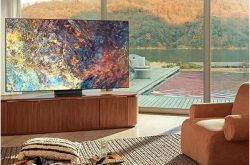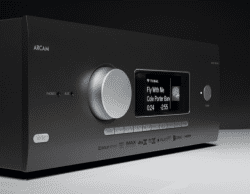Dolby Vision HDR: Everything You Need to Know

What is Dolby Vision HDR? How does it work? And, most crucially, how can you take advantage of the HDR format?
Dolby has played a key role in the development of HDR for both commercial cinema and home theatre applications. From a home entertainment perspective, the company’s most important contribution has been the advanced form of HDR (High Dynamic Range), known as Dolby Vision.
Dolby Vision has the potential to improve consumers’ viewing experience by constantly optimizing the way their TVs deliver HDR pictures – just as the rival HDR10+ format does. It also gives content producers more control over how their HDR programming appears on TVs. And it’s slowly coming to smartphones and tablets, too: it’s supported on most iPhones now, including the iPhone 13 and iPhone 13 Pro. The iPhone 12 Pro can even film footage in Dolby Vision.
It was originally widely assumed that Dolby Vision hardware (screens and Ultra HD Blu-ray players) needed to carry a dedicated chip. However, it is now possible to add Dolby Vision support via a firmware update to devices with sufficiently powerful processors.
The industry standard HDR10 format is free for manufacturers to use, but Dolby Vision requires the payment of a licence fee. So what’s so special about Dolby Vision that hardware brands and consumers would pay extra for it? Quite a bit, actually.
What is Dolby Vision?
The most significant advantage of Dolby Vision HDR versus HDR10 is the addition of dynamic metadata to the core HDR image data.
This metadata carries scene-by-scene instructions that a Dolby Vision-capable display can use to make sure it portrays the content as accurately as possible. Dolby Vision-capable TVs combine the scene-by-scene information received from the source with an awareness of their own capabilities in terms of brightness, contrast and color performance.
With HDR10 content, your HDR TV only receives static metadata; relatively basic ‘global’ information on the content being shown that applies to the entire film or TV show.
It can’t provide a display with updates on how each specific shot or scene should be shown. Nor does HDR10 carry the same facility for continually optimizing the picture to the capabilities of the screen it’s showing on.
Dolby Vision is built on the same core as HDR10, which makes it relatively straightforward for content producers to create HDR10 and Dolby Vision masters together. This means that a Dolby Vision-enabled Ultra HD Blu-ray can also play back in HDR10 on TVs that only support that format.
Dolby Vision allows content producers to have either one or two ‘layers’ of data; one carrying just an HDR signal, the other carrying a standard dynamic range (SDR) signal. This single HDR/SDR workflow approach makes Dolby Vision a convenient tool for content creators and broadcasters to use.
Another advantage of Dolby Vision is that the metadata is embedded into the video signal, meaning it can run across ‘legacy’ HDR connections as far back as version 1.4b. Despite only using static metadata, HDR10 requires HDMI 2.0a compatibility.
On the content production side, Dolby Vision seems more focused on pushing HDR to its technical limits. The minimum specification for Dolby Vision mastering requires the use of reference monitors with a contrast ratio of 200,000:1, peak brightness of 1000 nits, color range ‘approaching’ the REC 2020 standard, and support for the SMPTE ST-2084 HDR format.
However, Dolby has also developed a reference ‘Pulsar’ monitor that provides an 800,000:1 contrast ratio, a peak brightness of 4000 nits, and the so-called P3 color range used in digital cinema applications.
Given its greater creative palette, and the drive towards delivering consumer TVs with ever greater brightness, it’s certainly tempting to see this Dolby Pulsar monitor as a glimpse of HDR to come.
Does Dolby Vision deliver better pictures?
Our initial experience of Dolby Vision in the UK was originally limited to a few Netflix and Amazon streams, plus a handful of Dolby Vision film clips viewed on LG Dolby Vision TVs, and our first impressions were that Dolby Vision makes a difference for the better.
In a head-to-head comparison of Dolby Vision and HDR10 demo clips, Dolby Vision images appeared to contain more tone definition in bright areas; more balanced, nuanced and natural colors right across the spectrum; better contrast range management; and a greater sense of detail – presumably a side effect of the color and light management improvements.
However, we’ve since done a head-to-head comparison using two discs: Despicable Me and Power Rangers in 4K Blu-ray, and the results were unexpected. With Despicable Me, the Dolby Vision effect came across looking rather flat and contrast was more subdued; it was surprisingly less vibrant and spectacular than the HDR10 version of the film.
The Dolby Vision version of Power Rangers, however, is even punchier and more vibrant than the HDR10 alternative, with more nuance thanks to the extra detail revealed in the brightest and darkest areas of the image. It’s not utterly transformative, but it is quite clearly better.
Since Dolby Vision is applied on a disc-by-disc and frame-by-frame basis, it could well be that Despicable Me just isn’t a particularly good example of its implementation, while Power Rangers is more typical of what you can expect from the format.
We’ve since watched many more Dolby Vision discs – Wonder Woman, 1917, Justice League, Joker, Spider-Man: Homecoming, Star Wars: The Last Jedi, Venom and Bumblebee to name a few – and what’s clear is that, when implemented correctly, Dolby Vision can produce marked improvements on an already-impressive HDR10 presentation but it does vary from film to film.
We can only take each disc on its own and see how well Vision performs on a case by case basis.
How can you watch Dolby Vision?
With more and more 4K Blu-ray discs with Dolby Vision hitting the shelves, an increasing number of 4K Blu-ray players now come with Dolby Vision support as standard, including top-end five-star players like the Cambridge CXUHD, Panasonic DP-UB9000 and Panasonic DP-UB820EB. The Sony UBP-X700 and Sony UBP-X800M2 are excellent mid-range options.
It’s a more complicated story when it comes to TVs. Not all manufacturers support Dolby Vision and those that do don’t implement Dolby Vision on all their models. You’ll tend to find it on all but the very budget end of their ranges. LG and Sony have Dolby Vision on the lion’s share of their TVs. Philips and Panasonic are usually compatible with both HDR10+ and Dolby Vision, but Samsung is HDR10+ only.
Sony continues its TV support into 2020 and 2021 with its headline premium 8K and 4K TVs, while LG also continues to be fully onboard the Dolby Vision bandwagon with its 2020 TVs and 2021 LG TV line-up too.
Dolby Vision is also available via the Apple TV 4K, Google Chromecast Ultra and Google Chromecast with Google TV.
What Dolby Vision content is available?
A number of major film studios (including Lions gate, Sony Pictures, Universal and Warner Bros.) have all released Dolby Vision UHD Blu-rays.
Despicable Me and Despicable Me 2 had the distinction of being the first 4K Blu-ray titles with Dolby Vision to hit the market. Not the most scintillating start, but it’s picked up since then. Existing titles include Solo: A Star Wars Story, Avengers Infinity War, Jurassic World – Fallen Kingdom and many more.
Things are a bit more advanced on the streaming side. In the UK, Disney Plus, Netflix, Apple TV+ and Amazon Prime Video support Dolby Vision HDR streams, while in the US they are joined by VUDU.
Netflix shows that support Dolby Vision include Marvel’s Daredevil, Jessica Jones, Luke Cage and Iron Fist, as well as other Netflix Originals such as Lost in Space, Altered Carbon, Santa Clarita Diet, Stranger Things series two and Dynasty.
Amazon Video is a little more sparse when it comes to Dolby Vision, with a more limited amount of content available, including Jack Ryan and a handful of Sony Pictures films such as After Earth, Fury, Elysium, Men in Black 3 and The Amazing Spider-Man 2.
More recently, Rakuten has partnered up with Dolby and LG to bring Dolby Vision (and Atmos) movies to its film rental service. Titles include modern blockbusters such as Blade Runner 2049 and Baby Driver and older films such as Bad Boys II and The Amazing Spider-Man.
Disney Plus has had a huge store of Dolby Vision content since launch, much of which is also Dolby Atmos compatible too. The bulk of the Marvel movies and Star franchise are included as are the big Disney and Pixar hits and the likes of Pirates of the Caribbean.
The PC game Mass Effect: Andromeda was the first game to support Dolby Vision, heralding a whole new outlet for the format. The Xbox One X and S both support Dolby Vision following a software update, and the more recent generation, the Xbox Series X and Xbox Series S are Dolby Vision and Atmos-enabled too, with Microsoft testing the feature in beta. The Apple TV app on Xbox was recently updated to add Dolby Vision, too.
However, it’s unlikely Dolby Vision support will arrive on Sony’s PlayStation 4 or PS5.
Dolby Vision can also be applied in a live broadcast environment – though we’re not aware yet of any broadcaster announcing plans to use it. Besides, another format, Hybrid Log Gamma (HLG), is currently the default format used with 4K broadcasts.
What’s the future of Dolby Vision?
It’s of course not just consumer products that support Dolby Vision. The UK’s first Dolby Cinemas offering Dolby Vision and Atmos are now open, proving yet further that the company is eager to get Dolby Vision in front of more eyes. The technology is now well established and well supported in the AV industry, and, with Dolby Vision IQ now a thing too, looks to only get better and better.
There’s no doubt the current HDR landscape is a little rocky, especially when you throw HLG (the broadcast HDR TV format) and, more crucially, Vision’s main rival, HDR10+, into the equation. Then there’s also the IMAX Enhanced standard creeping up on the horizon too.
Unfortunately, there’s a chance it could get more confusing as the new formats and standards settle. But fear not – we’ll be on hand to help you cut through the jargon.




